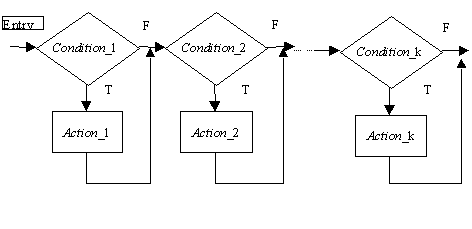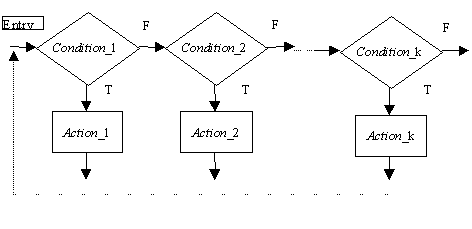4.6 Decision lists, decision tables, decision trees
In this section three simple tools for encoding decision procedures are
outlined in brief. These tools are decision lists, decision tables, and
decision trees. Any of them is aimed at providing operational support for
efficient decision making. Any of them introduces a specific structure
into the decision process and allows for algoritmization of decision procedures.
Although the tools are relatively simple, they allow for multilevel hierarchical
decision making and thus can be used for encoding quite complex decision
support procedures.
Decision lists
Decision lists are one of the conceptually simplest tools for encoding
process of decision support. A decision list is composed of a sequence
of pairs (binary condition, action). Its use consists in
sequential checking of the list items, and every time when the condition
is satisfied, the appropriate action is executed; then next pair is examined.
Note that from logical point of view, the conditional part
is just a proposition logic atomic formula, and thus it is evalueted
to true (T) or false (F). Its definition is usually formulated
as a question concerning status, position, current state, etc. of some
switch, device, item or object. Depending on the answer, an asigned action
is executed or not.
There can be two basic oragnizations of decision lists. The first one
is simple linear; in such an organization the conditions are examined in
turn, every time when the condition is evaluated to true the appropriate
action is executed; then the next condition is evaluated, etc. Thus, in
linear organization every condition is evaluated once and all the list
is scanned along disregarding if any actions (and which) were executed.
A graphical scheme of such a list is presented below.

A linear decision list
After entering the list, the first condition is evaluated. If it is
true
(T), the first action is executed. Disregarding the results and the condition
value, the following condition is evaluated next, etc. After coming to
the end of the list, either the scanning proces can be repeated (in a closed
loop) or the operation can be terminated. Initiation of the entry to specific
decision list can be the result of execution of some higher order prcedure
or satisfaction of some entry conditions. The actions may represent real
operation on the supervised system, decisions, or just certain conclusions
to be inferred.
Another possibility of organization of a decision list consists in hierarchical
structure. The principle is that the most constrainng condition (the
strongest one, the most important one) is evaluated first, and if found
to be true, the appropriate action is executed; the list is abandoned and,
possibly, interpreted once again from the beginning. If the first condition
is false, the following conditions are evaluated sequentially until encountering
the first one true. Then the appropriate action is executed and the list
is abandonned. This king of organization is schematically presented in
the figure below.

A hierarchical decision list.
The main applications of linear decision lists take place in situations
where more or less equally important conditional activities are to be performed
sequentially, and perhaps in a closed cycle; this includes routine checking
of some external conditions, specification of simple reactive systems,
etc. On the other hand, hierarchical decision lists are applied mainly
for encoding conditional actions ordered according to some priorities,
i.e. an action of higher priority should be always executed before and
action having lower priority, provided that their conditions are satisfied.
Decision trees
A useful, engineering way of knowledge representation for decision making
may consist in further structuring the knowledge with use of different
tree-like representations. Thus a decision tree can be considered to be
an extension of decision lists concept.
Tree-like representation are readable, easy to use, and generally accepted
structures displaying in an intuitive form some decision or classification
procedure. The root of the tree is the entry node, and under any node there
are some branching links. The selection of a link is carried out with respect
to a conditional statement assigned to the node. Evaluation of this condition
(either to true or false in case of binary trees, or to one of prespecified
values in case of more complex trees) determines the selection of the link.
The tree is traversed top-down, and at the leafs final decision or classified
object are encountered.
The basic form of decision tree is a binary decision tree. Any
node in such a tree (apart from leaf nodes) is assigned a binary condition
equivalent to a propositional formula. Below any such node there are normally
two branches, one corresponding to the sequence of traversing the three
is the assigned condition is true (T) and the other one corresponding
to the case when the condition is false (F). A graphical scheme
of such a tree is outlined below.

A simple binary decision tree.
A decision tree may have nodes corresponding not only to binary
branching. For example, a node may be assigned a question concerning the
value of certain attribute, and there may be as many links going out of
this node as many possible values for the specified attribute exists. For
practical reasons the number of possible branches is usually limited to
just several. Decision trees can be also organized in a hierarchical way,
i.e. the leaf node of an iupper level decision tree can be the root node
for a lower level decison tree.
In particular, in certain cases a decision tree can take the form of
of a decision graph, i.e. certain branches are linked together in order
to avoid specifying the same questions in the same or similar situations
for many times. It is important, however, that a decision tree is always
traversed top-down, ie. even if it takes the form of a graph, no cycles
can be introduced.
Decision tables
Another similar idea is a decision-table. A decision table is a table displaying
sequences of conditions which must hold for executing specific actions.
The sequences of conditions are displayed in a readable form, either vertically,
as parts of columns of the decision table, or horizontally, as parts of
row of the table.
A classical form of decision table is the vertical one. where condition_i
specifies the conditions to be examined, and action_i defines the
action to be executed. The values v_ij can take + if the condition
must hold for certain action to be executed, -if the condition cannot hold
(if it holds, then the action cannot be executed), and * (or empty place)
which means that the action is condition-independent. The values w_ij
take + if the action is to be executed, provided that the vertical condition-defining
sequence above is satisfied, or - (or empty space) if the action need not
be performed. A generic for of such a decision table is presented below.
| condition_1 |
v_11 |
v_12 |
 |
v_1n |
| condition_2 |
v_21 |
v_22 |
 |
v_2n |

|

|

|
 |

|
| condition_k |
v_k1 |
v_k2 |
 |
v_kn |
| action_1 |
w_11 |
w_12 |
 |
w_1n |
| action_2 |
w_21 |
w_22 |
 |
w_2n |
 
|

|

|
 |

|
| action_m |
w_m1 |
w_m2 |
 |
w_mn |
The evaluation of the table proceeds as follows: any column
of values specifying action prerequisites is traversed top-down, and the
defined sequence of true and false conditions is verified. If the pattern
is matched, the actions specified below are executed, and subsequent column
of conditions is analyzed. In stable environment, the conditions can be
evaluated once for processing of all the table, and then only conditional
sequences are matched against the current pattern of true and false conditions.
The main advantage of a table as above consists in simple,
intuitive interpretation. Further, the evaluation procedure can be speeded
up due to singular evaluation of conditions during each cycle. Furthermore,
tables can be organized in a hierarchical manner, i.e. certain action may
consist in going to analysis of a lower order, more specific table (an
action similar to the ''go to'' instruction in some programming languages).
One of the main disadvantages consists in possibility of defining the preconditions
of actions with use of binary values only, and in some cases the use of
values of attributes is more convenient. A slightly extended table, the
so-called Object-Attribute-Value Table (OAV Table, OAT) is presented below.
| attrib_1 |
attrib_2 |
 |
attrib_k |
action_1 |
action_2 |
 |
action_m |
| v_11 |
v_12 |
 |
v_1k |
w_11 |
w_12 |
 |
w_1m |
| v_21 |
v_22 |
 |
v_2k |
w_21 |
w_22 |
 |
w_2m |
 |
 |
 |
 |
 |
 |
 |
 |
| v_n1 |
v_n2 |
 |
v_nk |
w_n1 |
w_n2 |
 |
w_nk |
The OAV table is very similar to relational database table,
and in fact it is a RDB with specific interpretation of certain columns.
The basic scheme is presented below.
In the above table, the rows specify under what attribute values certain
action must be executed. Since both v_ij and w_ij may take
many different values (not just true/false, or unimportant, as in the former
case), the approach is more general than the former, classical table. In
case of actions, the specific values may indicate if the action is to be
applied or not, but they can also specify some parameter of the action
associated with specific column. The
interpretation (and execution) of this table is straightforward: the
rows are examined in turn, and the current values of subsequent attributes
are determined; if they match the pattern specified in the examined row
(i.e. the specification given in the examined row is more general than
the provided current specification), the actions specified in the right-hand
part of the table are executed, and next rows is examined. Of course, hierarchical
organization of tables is also possible.



